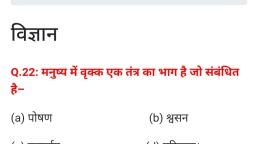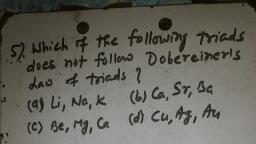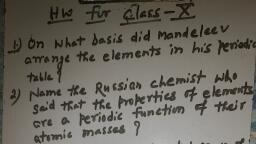Question 4 :
The distance between the centre of a nucleus and the outermost orbit of the atoms is called__________.
Question 6 :
Which of the following is a correct statement about non-metallic atoms?
Question 9 :
Mark the statement which is not a correct property of metals?<br/>a) All metals exhibit colour.<br/>b) All metals are solid at room temp.<br/>c) Metals are electronegative in nature.
Question 13 :
Most metallic element has the following electron arrangement in its atom is<span> :</span><br/>
Question 16 :
The distance between the centre of nucleus and the outermost shell of an isolated atom is known as<span> :</span>
Question 18 :
What is the Trends of Variation of atomic radius along a period?
Question 19 :
Which of the following is a correct statement about metallic atoms?
Question 21 :
The correct order of size of the three species $Ca,$ $Ca^+$ and $Ca^{2+}$ is<span> :</span>
Question 22 :
Listed below are the electronic configuration of five elements. Arrange the elements in the increasing order of metallic character:<div><br/>(a) $[Ar] 3d^{10} 4s^2$    </div><div>(b) $[Ar] 4s^2$<br/>(c) $[Ar] 3d^{10} 4s^2 4 p^6 5s^2$     </div><div>(d) $[Ar] 3d^{10} 4s^2 4 p^5$<br/>(e) $[Ar] 3d^{10} 4 s^2 4 p^6 5s^1$</div><div><br/></div>
Question 23 :
Which of the following increases the acidic character of compounds of central element $(E)$?
Question 25 :
An element has cubic close packed structure. The distance between adjacent layers is $424.2$ pm. What would be the atomic radius of the element?
Question 27 :
The $C-C$ and $Si-C$ inter-atomic distance are $154\ pm$ and $188\ pm$. the atomic radius of $Si$ is:
Question 28 :
Which of the following set of elements is written in order of their increasing metallic character?
Question 30 :
Which of the following elements, having atomic number as below possesses non-metallic property?
Question 32 :
The term periodicity is the properties of elements, which are arranged in the increasing order of their atomic numbers. Then the elements with similar properties:<br/>
Question 34 :
In which one of the following pairs the radius of the second species is greater than that of the first ?
Question 35 :
Which characteristics are required for a element to behave as electrical conductor?
Question 36 :
<div><span>Name the element with the biggest atomic radius of the following:</span><br/></div>
Question 39 :
Arrange the following elements in the order of their increasing non-metallic character:<div><br/>Li, Be, C, O, F<br/></div>
Question 40 :
The number of gases present in long form of the periodic table are:<br/>
Question 41 :
The correct sequence which shows decreasing order of the ionic radii of the elements is: 
Question 42 :
The ground state electronic configurations of the elements, U, V, W, X and Y (these symbols do not have any chemical significance) are as follows:<br>U $1s^2 2s^2 2p^3$ V $1s^2 2s^2 2p^6 3s^1$<br>W $1s^2 2s^2 2p^6 3 s^2 3p^2$ X $1 s^2 2s^2 2 p^6 3s^2 3p^6 3d^5 4s^2$<br>Y $1 s^2 2s^2 2p^6 3s^2 3p^6 3d^{10} 4s^2 4 p^6$<br>Determine which sequence of elements satisfy the following statements:<br>(i) Element forms a carbonate which is not decomposed by heating<br>(ii) Element is most likely to form coloured ionic compounds<br>(iii) Element has largest atomic radius<br>(iv) Element forms only acidic oxide
Question 43 :
If the nucleus $_{13}^{27}Al$ has a nuclear radius of about 3.6 fm, the $_{52}^{125}$Te would have its radius approximately as:<br>
Question 44 :
Which one of the following is correct order of increase of size:
Question 45 :
Which of the following choices both show the correct order of elements by increasing atomic radius AND by increasing ionization energy?

































